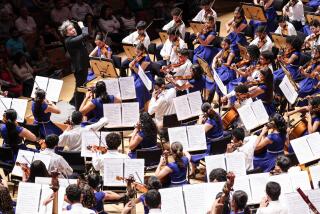L.A. Master Chorale Presents Madrigals for Spring Afternoon
When USC’s Donald Crockett presented Los Angeles Master Chorale music director Grant Gershon with two newly composed madrigals under the title “Broken Charms,” Gershon ran with the idea and designed an entire program around them. Hence “Magnificent Madrigals,” at Royce Hall on Sunday afternoon, where “Broken Charms” (a world premiere) and Frank Martin’s “Songs of Ariel” (1950) provided contemporary anchors for three thematically matched sets of artifacts from the madrigal’s heyday.
Indeed, Crockett’s pair of a cappella pieces--with texts by Elizabethan poets Samuel Daniel and Thomas Campion--were well worth showcasing, for they play with sound in a strikingly emotional way. The setting of Daniel’s “Care-Charmer Sleep” establishes its base in the lower male voices with splendidly dark contemporary harmonies. Campion’s “Thrice Toss These Oaken Ashes in the Air” is underlined by drones of humming voices while others seem to simulate chimes, building to a delicious near-cacophony of thick moving chords toward the close.
With the season in mind--and half-joking apologies from Gershon for keeping the audience indoors on a beautiful spring day--the English and Italian madrigals were gathered under the titles “Spring Has Sprung,” “Variable Love” and “Feathered Friend.” Because the early music movement usually has exclusive custody of Renaissance music these days, it was a welcome shock to hear a robust symphonic choir applying its powerhouse sound and exquisitely modulated dynamics to this material.
Particularly effective was the bird set, with the serenely gliding swans of Jacob Arcadelt and Orlando Gibbons and Monteverdi’s cascading “That Little Bird That Sings So Sweetly.” In this context, Martin’s “Songs of Ariel,” based on texts from Shakespeare’s “The Tempest,” seemed like a continuation of the Renaissance composers’ tone-paintings, but with a more acerbic 20th century accent.
More to Read
The biggest entertainment stories
Get our big stories about Hollywood, film, television, music, arts, culture and more right in your inbox as soon as they publish.
You may occasionally receive promotional content from the Los Angeles Times.










